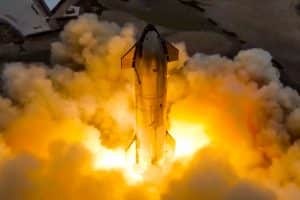In its true last act of the year, SpaceX successfully fired up its first orbital-class Starship for the fourth time in approximately two months, placing the prototype one step closer to flight readiness.
Starship S20 first left its roost in SpaceX’s Starbase factory in early August, briefly performing a fit test atop Super Heavy Booster 4 (B4) – both only partially complete at the time. Both returned to their nests for finishing touches soon after. However, relative to almost all other prototypes SpaceX has built in South Texas in the last two years, Starship S20’s path to flight readiness has been a long and windy one. It took SpaceX a full eight weeks after that first rollout to prepare Ship 20 for – and complete – its first cryogenic proof test, in which the rocket was pressurized and filled with hundreds of tons of liquid nitrogen (LN2).
It took another three weeks after that milestone for SpaceX to then prepare Ship 20 for an even more important test – its first Raptor engine static fire.
The process began on October 19th with Ship 20’s first Raptor preburner test, in which smaller secondary combustion chambers designed to supply the engine’s main combustion chamber with a combustible mixture were briefly ignited on their own. On October 21st, that next milestone finally came, with Starship S20 not only completing the first on-pad static fire of a Raptor Vacuum engine but also performing a second test during the same window, firing up the same RVac and a gimballing Raptor Center (RC) engine less than an hour later. It was an impressive leap in apparent confidence, with Ship 20 jumping from the slowest prototype to reach a testing milestone to the first prototype of any kind to complete back-to-back static fires less than an hour apart.
After another unusually long three weeks of work, some of which was spent installing four more Raptors on Starship S20, the ship completed a second preburner test – the first of any kind to simultaneously feature or involve six Raptor engines. Unlike the first campaign, which had a two-day gap, SpaceX then turned S20 around in the same window and performed the first six-Raptor Starship static fire 50 minutes later – both a success, according to CEO Elon Musk.
Another Ship 20 static fire was subsequently attempted another three or so weeks later, ultimately resulting in an abort on December 1st. Only four weeks later did SpaceX try again, successfully completing what appeared to be Starship S20’s second six-engine static fire without issue on December 29th. The company attempted a second static fire a few hours later but that try was less lucky, culminating in an abort seconds before ignition and wrapping up the day’s testing. That brings us to today, January 2nd, 2022, where SpaceX is once again preparing for more Ship 20 testing with eight-hour windows on January 4th, 5th, and 6th.
The goals of these continued static fire tests are less clear than some past SpaceX testing but Ship 20 – the first orbital-class prototype and first Starship to test more than three Raptors at a time – is a valuable pathfinder. While SpaceX would likely have benefitted even more from them weeks or months, all lessons learned from Ship 20 will help guide retroactive modifications and proactive design changes for upcoming prototypes – the statuses of which are currently in flux.





